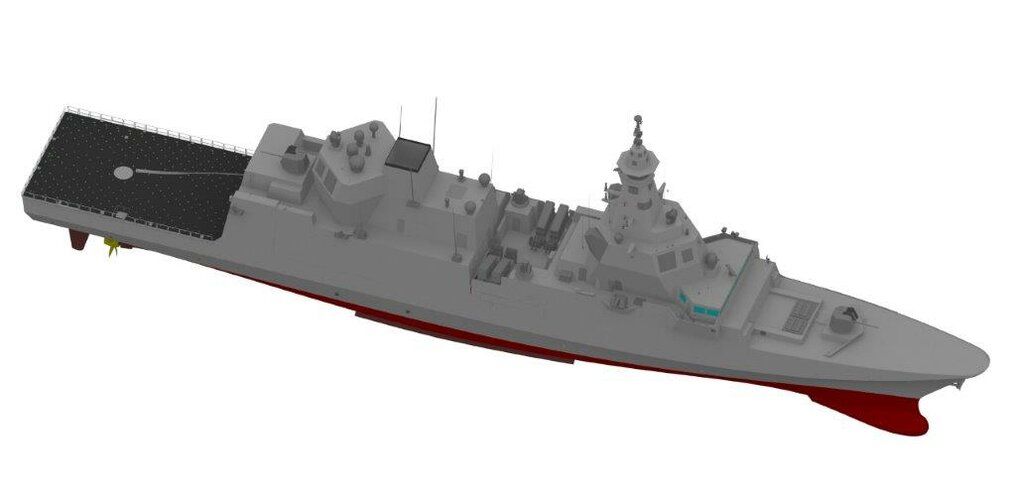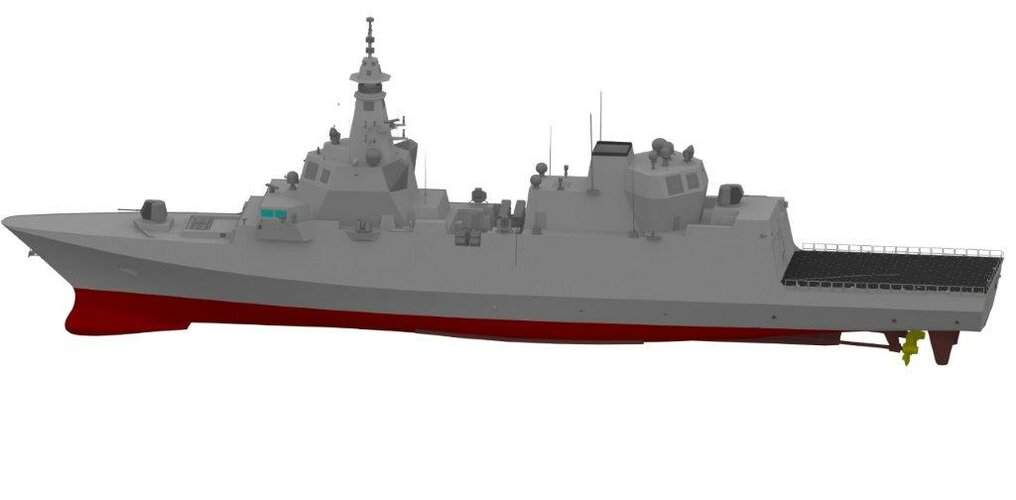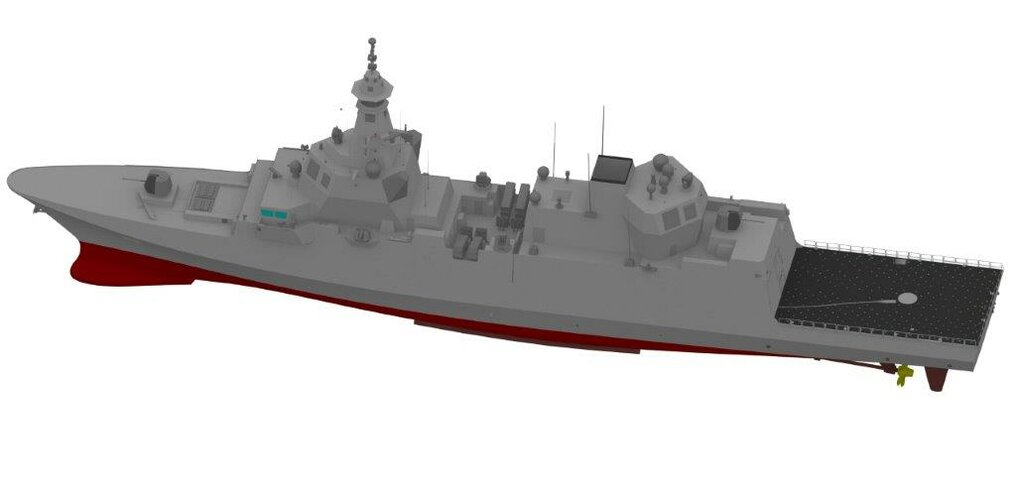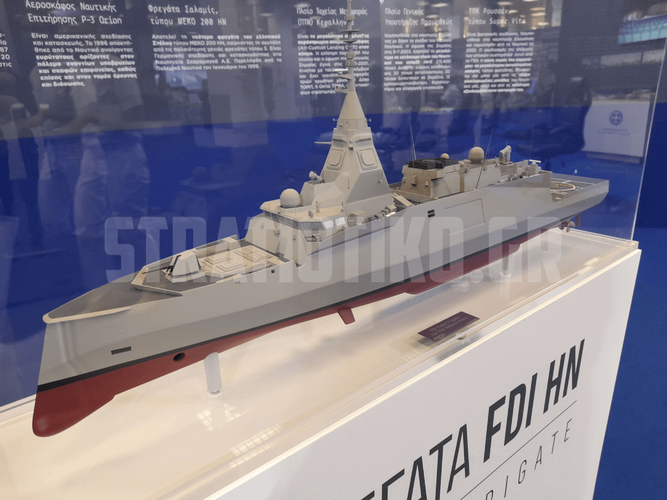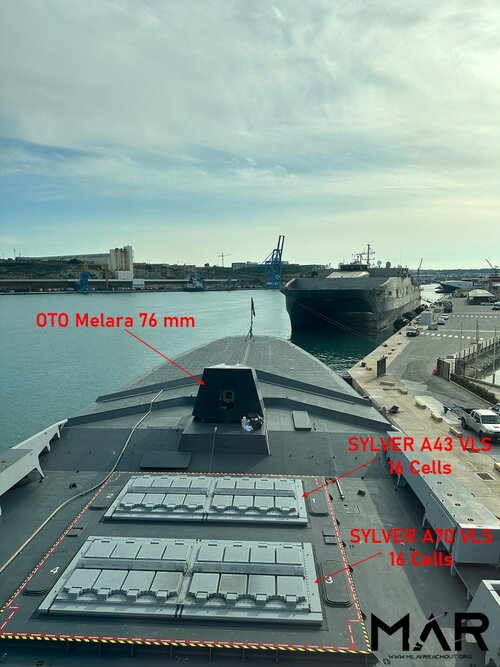Phoenix_jz
ACCESS: Confidential
- Joined
- 1 April 2020
- Messages
- 67
- Reaction score
- 227
Since there aren't any large threads for FREMM already, I figured I would create one specifically to discuss the background and development of the FREMM-EVO, a pair of interim frigates ordered for the Marina Militare Italiana.
Background:
Before we talk about the FREMM-EVO, we should talk about the earlier FREMM variants. The FREMM was jointly developed by France and Italy to meet requirements for a future ASW frigates. The Italian half of the program was for ten frigates - four in an Anti-Submarine Warfare (ASW) Configuration, and six in a General-Purpose (GP) configuration. The primary difference between these variants is that while the former have a towed VDS (CAPTAS-4) and two 76/62 naval guns, the GP variant lacked the towed VDS in favor of a rapid launch and recovery ramp for large RHIBs, and had a 127/64LW forward in place of a 76/62. This focus on GP ships over ASW was part of a general shift of the 1990s-2000s that placed more emphasis on peacekeeping and patrol operations than serious warfighting, given the reduced submarine presence with the end of the Cold War. By the 2010s, however, this was recognized as an error. Not only did Russian activity become resurgent, but procurement of submarines by non-NATO nations in the Mediterranean increased considerably. Only procuring four dedicated ASW frigates would be stretching these assets too thinly.
In 2020, Fincantieri sold the final pair of FREMM-IT-GP to Egypt while they were still under their ownership, under agreement with the Italian government. Fincantieri was contractually obligated to still deliver the final pair of FREMM-IT-GP to the Marina Militare and would cut steel on two new ships in 2021. The Marina Militare took the opportunity to order a modified configuration, alternatively called the 'Enhanced' or 'Hybrid' variant (originally rendered as GPe), which effectively adopted the sensors and countermeasures of the ASW configuration while retaining the 127/64LW forward. These frigates were 'hybrid' in other senses and contained other enhancements over the first eight FREMM-IT. The platform management system was replaced by a new, more comprehensive 'Ship Management System' by Fincantieri NexTech, and the electronic warfare suite was replaced by the new generation system - Zeus/Virgilius fielded on the units of the 2014 naval program (Trieste & the PPA).
FREMM-EVO
Public information about the FREMM-EVO goes back to about February 2023, though the project almost certainly started early. As part of a series of hearings of the Italian Senate Defense Commission by the service heads (Chiefs of Staff) of the Italian armed forces, CSMM Adm. Credendino laid down an operational requirement for an additional 3-6 ASW Frigates on top of the existing force of ten FREMM (4x GP, 4x ASW, 2x 'Hybrid') planned up to that date. Based on interviews with RID (03/23) around the same time, Credendino's drive for procurement was more modest, in the region of 2-4 additional ASW frigates.
Two different FREMM designs appear to have been in development at this time. The first was a long-term solution variably called either 'FREMM 2.0' or 'FREMM-NG' ('Next Generation'), which would be a larger successor to the existing FREMM design, incorporating new technologies and greater growth margin versus the existing hull. This was a long-term solution.
News quickly emerged about a short-term design, studies for which were to be funded under the DPP 2023-25. In June of 2023, RID reported that these two new frigates (no.13 and 14 of the overall Italian build program, but 11th and 12th for Italian service) would be adopting the fixed-face Kronos Quad (GaN AESA, C-band) in place of the rotating Kronos Grand Naval (MFRA, also a C-band AESA), but not the full Kronos Dual Band Radar (incorporating the X-band Kronos Starfire) due to the more extensive re-design that would require. This would not fit in line with the navy's timescale.
Evidentially something changed in that regard in the next few months, and in October 2023 RID reported that the design - now being called FREMM-EVO - would in fact incorporate the full Krono Dual Band Radar (C & X-band), and would utilize the Aster 30 Block 1NT interceptor out of their 16 VLS cells. This indicated the adoption of the SADOC 4 CMS and SAAM-ESD++ air warfare system used by the PPA Full. In February 2024, the draft decree for the FREMM-EVO program was sent to Parliament for approval, with the entire program coming in at €2bn.
As part of an article on Marina Militare programs in RID 01/24, RID published an early render of the design:

In March 2024, RID reported that as part of studies for FREMM-EVO, the integration of CAMM-ER was being considered.
On 31 July 2024, the contract for the construction of the FREMM-EVO was signed with OSN (a joint venture between Fincantieri and Leonardo) for the procurement of the vessels, with a value of €1.5bn (€750M per ship). On top of previously described features, the FREMM-EVO would be equipped with two 76/62 Strales systems rather than a 127/64LW + 76/62 Strales, as first indicated. They would also replace the previously ubiquitous 25mm KBA weapon systems with the Lionfish 30 as part of a new integrated anti-drone system. A drone management system would also be integrated into their CMS for use with UAVs, USVs, and UUV's, and they would also adopt the new-generation IFF and datalink systems. The missile armament remained the same in number as the prior FREMM, but with enhanced capabilities - eight Teseo Mk.2 EVO in place of the Mk.2/A, and Aster 30 Block 1NT from the 2x8 Sylver A50 VLS. The ships would remain FFBNW two modules (2x8) for strike-length cells.
With the contract, new official renders were released;

More recently, in October 2024 RID reported that unlike the first ten FREMM - which have accommodations modules installed in the location of the strike-length cells - the FREMM-EVO will keep that space reserved only for additional VLS (thus reducing total accommodations). Studies are ongoing as to whether or not the ships will keep the space open for future VLS, fit 2x8 A70 VLS for the MdCN land attack cruise missile as an interim solution, or the fitting of soft launch tubes for CAMM-ER (12 at a minimum). Additionally, RID reported on details of the new 'ADRIAN' anti-drone system that would be integrated into ship. ADRIAN is designed to tackle sub-100 kg drones, and will function fully integrated into the ship’s electronic warfare system while also taking tracks from the Kronos DBR and the DSS-IRST. Despite this, it will also have a separate dedicated X-band radar, either the OMEGA 360 by Fincantieri NexTech or the TMMR (Tactical Multi-Mission Radar) by Leonardo. There will also be a separate dedicated jammer for attacking drones and potentially hijacking them, though the system can also destroy the drone with the ship’s weapons.
In an interview with CSMM Admiral Credendino released by RID today (28 October 2024), RID asked;
To which Credendino responded;
Note that the comment about 'the long range missile' is referring to longer-ranged missiles in general, versus the CAMM-ER, which had been mentioned in the prior question. The mention of a 'universal multi-missile launcher' is particularly noteworthy as it is known now that the Marina Militare is pushing for the development of what is generally known as the 'Sylver A70 NG' - an evolution of the existing A70, able to fire multiple ammunition types (MdCN, Aster, FC/ASW, Aquila) compared to the current Sylver A70 that only launches the MdCN land attack cruise missile.
Background:
Before we talk about the FREMM-EVO, we should talk about the earlier FREMM variants. The FREMM was jointly developed by France and Italy to meet requirements for a future ASW frigates. The Italian half of the program was for ten frigates - four in an Anti-Submarine Warfare (ASW) Configuration, and six in a General-Purpose (GP) configuration. The primary difference between these variants is that while the former have a towed VDS (CAPTAS-4) and two 76/62 naval guns, the GP variant lacked the towed VDS in favor of a rapid launch and recovery ramp for large RHIBs, and had a 127/64LW forward in place of a 76/62. This focus on GP ships over ASW was part of a general shift of the 1990s-2000s that placed more emphasis on peacekeeping and patrol operations than serious warfighting, given the reduced submarine presence with the end of the Cold War. By the 2010s, however, this was recognized as an error. Not only did Russian activity become resurgent, but procurement of submarines by non-NATO nations in the Mediterranean increased considerably. Only procuring four dedicated ASW frigates would be stretching these assets too thinly.
In 2020, Fincantieri sold the final pair of FREMM-IT-GP to Egypt while they were still under their ownership, under agreement with the Italian government. Fincantieri was contractually obligated to still deliver the final pair of FREMM-IT-GP to the Marina Militare and would cut steel on two new ships in 2021. The Marina Militare took the opportunity to order a modified configuration, alternatively called the 'Enhanced' or 'Hybrid' variant (originally rendered as GPe), which effectively adopted the sensors and countermeasures of the ASW configuration while retaining the 127/64LW forward. These frigates were 'hybrid' in other senses and contained other enhancements over the first eight FREMM-IT. The platform management system was replaced by a new, more comprehensive 'Ship Management System' by Fincantieri NexTech, and the electronic warfare suite was replaced by the new generation system - Zeus/Virgilius fielded on the units of the 2014 naval program (Trieste & the PPA).
FREMM-EVO
Public information about the FREMM-EVO goes back to about February 2023, though the project almost certainly started early. As part of a series of hearings of the Italian Senate Defense Commission by the service heads (Chiefs of Staff) of the Italian armed forces, CSMM Adm. Credendino laid down an operational requirement for an additional 3-6 ASW Frigates on top of the existing force of ten FREMM (4x GP, 4x ASW, 2x 'Hybrid') planned up to that date. Based on interviews with RID (03/23) around the same time, Credendino's drive for procurement was more modest, in the region of 2-4 additional ASW frigates.
Two different FREMM designs appear to have been in development at this time. The first was a long-term solution variably called either 'FREMM 2.0' or 'FREMM-NG' ('Next Generation'), which would be a larger successor to the existing FREMM design, incorporating new technologies and greater growth margin versus the existing hull. This was a long-term solution.
News quickly emerged about a short-term design, studies for which were to be funded under the DPP 2023-25. In June of 2023, RID reported that these two new frigates (no.13 and 14 of the overall Italian build program, but 11th and 12th for Italian service) would be adopting the fixed-face Kronos Quad (GaN AESA, C-band) in place of the rotating Kronos Grand Naval (MFRA, also a C-band AESA), but not the full Kronos Dual Band Radar (incorporating the X-band Kronos Starfire) due to the more extensive re-design that would require. This would not fit in line with the navy's timescale.
Evidentially something changed in that regard in the next few months, and in October 2023 RID reported that the design - now being called FREMM-EVO - would in fact incorporate the full Krono Dual Band Radar (C & X-band), and would utilize the Aster 30 Block 1NT interceptor out of their 16 VLS cells. This indicated the adoption of the SADOC 4 CMS and SAAM-ESD++ air warfare system used by the PPA Full. In February 2024, the draft decree for the FREMM-EVO program was sent to Parliament for approval, with the entire program coming in at €2bn.
As part of an article on Marina Militare programs in RID 01/24, RID published an early render of the design:
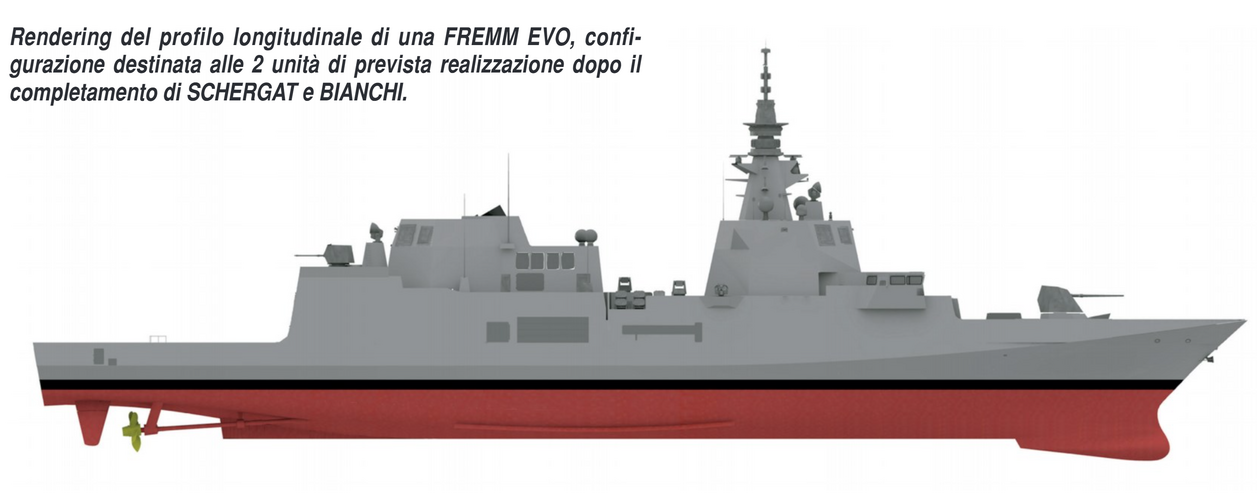
In March 2024, RID reported that as part of studies for FREMM-EVO, the integration of CAMM-ER was being considered.
On 31 July 2024, the contract for the construction of the FREMM-EVO was signed with OSN (a joint venture between Fincantieri and Leonardo) for the procurement of the vessels, with a value of €1.5bn (€750M per ship). On top of previously described features, the FREMM-EVO would be equipped with two 76/62 Strales systems rather than a 127/64LW + 76/62 Strales, as first indicated. They would also replace the previously ubiquitous 25mm KBA weapon systems with the Lionfish 30 as part of a new integrated anti-drone system. A drone management system would also be integrated into their CMS for use with UAVs, USVs, and UUV's, and they would also adopt the new-generation IFF and datalink systems. The missile armament remained the same in number as the prior FREMM, but with enhanced capabilities - eight Teseo Mk.2 EVO in place of the Mk.2/A, and Aster 30 Block 1NT from the 2x8 Sylver A50 VLS. The ships would remain FFBNW two modules (2x8) for strike-length cells.
With the contract, new official renders were released;
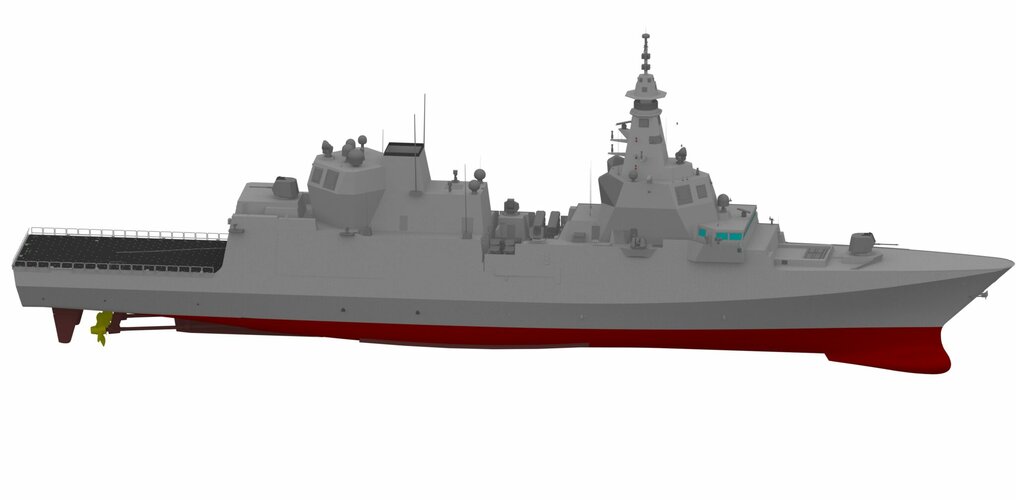
More recently, in October 2024 RID reported that unlike the first ten FREMM - which have accommodations modules installed in the location of the strike-length cells - the FREMM-EVO will keep that space reserved only for additional VLS (thus reducing total accommodations). Studies are ongoing as to whether or not the ships will keep the space open for future VLS, fit 2x8 A70 VLS for the MdCN land attack cruise missile as an interim solution, or the fitting of soft launch tubes for CAMM-ER (12 at a minimum). Additionally, RID reported on details of the new 'ADRIAN' anti-drone system that would be integrated into ship. ADRIAN is designed to tackle sub-100 kg drones, and will function fully integrated into the ship’s electronic warfare system while also taking tracks from the Kronos DBR and the DSS-IRST. Despite this, it will also have a separate dedicated X-band radar, either the OMEGA 360 by Fincantieri NexTech or the TMMR (Tactical Multi-Mission Radar) by Leonardo. There will also be a separate dedicated jammer for attacking drones and potentially hijacking them, though the system can also destroy the drone with the ship’s weapons.
In an interview with CSMM Admiral Credendino released by RID today (28 October 2024), RID asked;
And on the FREMM EVO, will there be missiles in the spaces previously occupied on the FREMM by additional dressing rooms?
To which Credendino responded;
Absolutely. We are studying various options, including the long-range missile, and we are asking the industry to develop a universal multi-missile launcher, which would give us greater flexibility and operational versatility.
Note that the comment about 'the long range missile' is referring to longer-ranged missiles in general, versus the CAMM-ER, which had been mentioned in the prior question. The mention of a 'universal multi-missile launcher' is particularly noteworthy as it is known now that the Marina Militare is pushing for the development of what is generally known as the 'Sylver A70 NG' - an evolution of the existing A70, able to fire multiple ammunition types (MdCN, Aster, FC/ASW, Aquila) compared to the current Sylver A70 that only launches the MdCN land attack cruise missile.

